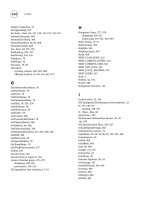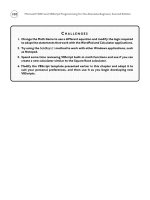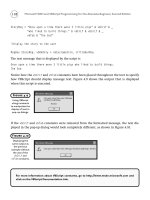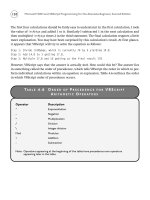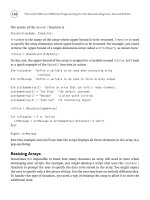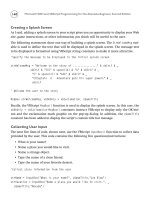Microsoft WSH and VBScript Programming for the Absolute Beginner Part 38 pdf
Bạn đang xem bản rút gọn của tài liệu. Xem và tải ngay bản đầy đủ của tài liệu tại đây (310.55 KB, 10 trang )
350
These new programming techniques provide you with tools for externalizing script config-
uration information, allowing you to change your script configuration settings without hav-
ing to make direct modifications to your scripts, and without having to worry about making
mistakes while you do it. In addition, I showed you how to use text files as another source
of data input for your VBScripts.
Microsoft WSH and VBScript Programming for the Absolute Beginner, Second Edition
C HALLENGES
1. Create new collection of word files to increase the number of categories avail-
able to the player.
2. Add an error-handling routine to the HangmanSetup.vbs script and use it to report
any problems that may occur when the script attempts to perform the RegWrite()
method.
3. Modify HangmanSetup.vbs to display a pop-up dialog that asks the user to agree to
abide by any terms that you choose to specify to play the game. Store a value
indicating whether or not the user has accepted the terms in the Registry. Check
this value each time the Hangman game is started, allowing the user to play only
if the terms have been accepted and prompting the user to accept the terms
again if they have not been accepted yet.
4. Create and store a variable in the Registry and modify Hangman.vbs to increment
it every time the game is started. Use this value to track the number of games
played. Check this value each time the game starts to determine whether it
exceeds a value of 20. Then, if the user has not yet accepted your terms, prevent
the game from running and force the user to accept your terms to play.
Working with
Built-In VBScript
Objects
11
CHAPTER
T
o get any real work done VBScript depends on access to objects and their
associated properties and methods. So far, you have learned how to work
with objects provided by the WSH and the VBScript run-time object
model. Besides these collections of objects, your VBScripts have access to a small
collection of built-in or core objects. Using these built-in VBScript objects, you
can create scripts that react to errors, create their own custom objects, and per-
form a host of complex parsing operations when dissecting the contents of
strings. Besides discussing VBScript’s built-in objects, this chapter also assists you
in creating a Tic-Tac-Toe game. Specifically, you will
• Review VBScript’s built-in objects and collections
• Learn how to define your own custom objects
• Learn how to associate properties and methods with custom objects
• Learn how to trigger events associated with custom objects
• Learn how to perform advanced string parsing operations
Project Preview: The Tic-Tac-Toe Game
In this chapter you will learn how to develop a Tic-Tac-Toe game. Through the
development of this game you will learn how to create and control a two-player
game. To do this you will have to develop the logic that controls who goes next,
while simultaneously making sure that every player’s move is valid. Figures 11.1
through 11.6 demonstrate the overall flow of the game from beginning to end.
CHAPTER
352
Microsoft WSH and VBScript Programming for the Absolute Beginner, Second Edition
Figure 11.1
The game begins
by displaying a
blank game board
and prompting
the first player to
make a move.
The game keeps track
of each player’s turn
Figure 11.2
The game
automatically
updates the game
board after each
player’s move.
The game validates all player
input to ensure that only valid
moves are accepted
Figure 11.3
Messages that
provide players
with additional
instruction when
needed are
posted at the
top of the game
board.
The game prevents players from
accidentally missing a turn by clicking
on a button without first providing input
By the end of this chapter you will have learned a great deal about how to work with
VBScript’s built-in collection of objects. You will also have developed your first multi-player
VBScript game.
Leveraging VBScript’s Built-In Collection of Objects
VBScript provides a small collection of built-in objects. The VBScript interpreter provides
access to these objects. Therefore, they are available to any VBScript regardless of the exe-
cution host running it. This collection of objects, though not numerous, provide VBScript
with a powerful arsenal of capabilities, including:
• Creating customized objects complete with their own properties and methods
• Intercepting and deal with run-time errors that your VBScripts may encounter
• Performing complex regular expression pattern matching
353
Chapter 11 • Working with Built-In VBScript Objects
Figure 11.4
The results of
each game are
posted at the top
of the game
board.
Figure 11.5
At the end of
each game,
players are
prompted to
play again.
Figure 11.6
The game ends
by displaying
information
about itself and
its author.
354
Microsoft WSH and VBScript Programming for the Absolute Beginner, Second Edition
Table 11.1 displays a list of VBScript’s built-in objects and provides a description of each
object, as well as a complete listing of all the properties, methods, and events associated
with the objects.
Object Description
Class Used to create new custom objects
Properties: This object does not have any associated properties.
Methods: This object does not have any associated methods.
Events:
Initialize, Terminate
Err Used to retrieve information about run-time errors.
Properties:
Description, HelpContext, HelpFile, Number, Source
Methods: Clear, Raise
Events: This object does not have any associated events.
Match Used to access read-only properties associated with a regular
expression match strings.
Properties:
FirstIndex, Length, Value
Methods: This object does not have any associated methods.
Events: This object does not have any associated events.
Matches Collection Represents a collection of regular expression Match objects.
Properties: This object does not have any associated properties.
Methods: This object does not have any associated methods.
Events: This object does not have any associated events.
RegExp Provides the ability to work with regular expressions.
Properties:
Global, IgnoreCase, Pattern
Methods: Execute, Replace, Test
Events: This object does not have any associated events.
SubMatches Collection Used to access read-only values associated with regular expression
submatch strings.
Properties: This object does not have any associated properties.
Methods: This object does not have any associated methods.
Events: This object does not have any associated events.
TABLE 11 .1 V B S CRIPT’ S C OLLECTION OF B UILT-IN O BJECTS
Built-In Object Properties
As you can see in Table 11.1, VBScript’s built-in objects have a number of associated properties.
A description of each of these properties is provided in Table 11.2.
Built-In Object Methods
Of all the VBScript built-in objects, only the Err object and the RegExp objects have methods
associated with them. Methods associated with the
Err object generate and clear errors as
outlined here:
•
Clear(). Clears out Err object property settings.
•
Raise(). Provides the ability to simulate a run-time error.
Methods associated with the
RegExp object provide the ability to search strings and to
replace portions of strings as outlined here:
•
Execute(). Performs a regular expression search.
•
Replace(). Replaces specified text during a regular expression search.
•
Test(). Returns a Boolean value indicating whether a matching pattern is located
within a string.
355
Chapter 11 • Working with Built-In VBScript Objects
Property Description
Description Returns error messages associated with the Err object
FirstIndex Returns the starting character location of a substring within a string
Global Returns a Boolean value
HelpContext Returns the context ID associated with Help file topic
HelpFile Retrieves the path of the specified Help file
IgnoreCase Returns a value of True or False depending on whether a pattern search is
case-sensitive
Length Retrieves the number of characters associated with a search string match
Number Retrieves an error number
Pattern Returns a regular expression pattern from a search operation
Source Returns the object name responsible for generating an error
Value Retrieves a value from a search string match
TABLE 11 . 2 B UILT- IN VBSCRIPT O BJECT P ROPERTIES
356
Creating Custom Objects
VBScript enables you to store data in constants, variables, and arrays. VBScript supports a
wide variation of variable subtypes, such as date, string, and integer. However, VBScript does
not provide for strict enforcement of variable subtypes, meaning that you can store any type
of value in any variable and then change the value type and value later on without raising
any errors. Although all this flexibility is great, it also makes it easy to introduce errors.
That’s why it’s best to use strict discipline when working with variables to ensure that you
don’t allow your scripts to mix data types. VBScript’s support for arrays provides for the stor-
age and retrieval of more complex data structures. But again, there is nothing built-in to
VBScript to prevent you from mixing and matching data types within your arrays.
By providing you with access to the
Class object, VBScript gives you the capability to create
complex data structures in the form of custom objects. You can then define properties and
methods for your custom objects. Once created, you can access custom objects just like you
do with any other objects. Custom objects help to improve data consistency because they
give you the capability to establish validation procedures that ensure data consistency and
enforce strict control over object manipulation.
Defining a Custom Object
You can create a custom object using the Class End Class statements. The Class object
provides a template for the creation of new objects. Once defined, custom objects must be
instantiated just like any other object. The syntax of the
Class End Class statement follows:
Class ClassName
Statements
End Class
ClassName
is used to specify the name assigned to the new object. Statements are variables,
properties, and methods that you define within the object. Object properties are defined for
objects by adding any of the following statements within the
Class End Class statement:
•
Property Get. Enables the retrieval of a value assigned to a private variable.
•
Property Let. Enables the modification of a value assigned to a private variable.
•
Property Set. Enables the modification of a value assigned to a public variable.
Microsoft WSH and VBScript Programming for the Absolute Beginner, Second Edition
Defining Object Properties and Methods
Within the Class End Class statements, variables, properties, and methods can be defined as
either private or public using the
Private and Public keywords. Labeling a variable, property
or method as
Private restricts access to only within the Class. Labeling a variable, property, or
method as
Public makes it accessible throughout a script.
When not specified, it is assumed that variables, properties, and methods are public.
However, it is generally not a good idea to allow variables to be defined with a public scope.
Making variables public removes the capability to strictly control their value within an
object. Instead, it’s better to make object variables private and then allow them to be
accessed using the
Property Get and Property Let statements.
To best demonstrate how all this works, let’s look at an example. Here a new custom object
is defined and assigned the name of
SuperHero.
Class SuperHero
Private strName
Public Property Let Name(strIdentity)
strName = strIdentity
End property
Function DisplayName
MsgBox “Our new hero’s name is “ & strName & “!”
End Function
End Class
The first statement defines the object and assigns its name. The next statement defines a
private variable named
strName. The three statements that follow define an object property
and make it writable by the rest of the script. The next three statements define a method
for the object called
DisplayName(). The last statement ends the definition of the SuperHero
object.
To exercise your new object definition, create a new script and add the preceding state-
ments to the script’s procedure section. Then add the following statements to the Initial-
ization section. These statements define a variable, and then use the variable to instantiate
a new
SuperHero object.
Dim objFirstHero
Set objFirstHero = New SuperHero
357
Chapter 11 • Working with Built-In VBScript Objects
358
Microsoft WSH and VBScript Programming for the Absolute Beginner, Second Edition
Once instantiated, you can assign a value to the object’s Name property by adding the fol-
lowing statement to the script’s Main Processing section:
objFirstHero.Name = “Captain Adventure”
You then can execute the object’s DisplayName() method by adding the following statement
to the main processing section:
objFirstHero.DisplayName()
Once assembled, the previous example displays the output shown in Figure 11.7 when executed.
Creating Event Procedures
Custom VBScript objects automatically support two events. These events execute as follows:
•
Class_Initialize. Executes whenever a new instance of an object is instantiated.
•
Class_Terminate. Executes whenever an instance of an object is destroyed.
The defining of these procedures is optional. When defined, the
Class_Initialize procedure
performs tasks such as the definition of variable default values. Similarly, the
Class_Terminate
procedure performs any cleanup that may be required once an object is no longer needed.
For example, the following statements define an initialization procedure for the
SuperHero
object from the previous example.
Private Sub Class_Initialize
MsgBox “In a blast of smoke and lightning another new super “ & _
“hero is born!”
End Sub
These statements must be added inside the Class End Class statements. Once defined, they
will automatically execute any time a new instance of the SuperHero object is established.
Figure 11.7
Creating and
instantiating a
new SuperHero
object.
If your script instantiates an object that it does not need anymore, it can destroy
that object instance as shown here.
Set objFirstHero = Nothing
In this example, the object instance is set equal to Nothing. This disassociates the
specified object variable from an object, releasing any memory allocated to it.
The following example further demonstrates how to define a custom object complete with
multiple properties and its own method and event definition.
‘*************************************************************************
‘Script Name: NewObjectDemo.vbs
‘Author: Jerry Ford
‘Created: 11/20/04
‘Description: This script demonstrates how to create a custom object
‘ with its own properties, methods, and events
‘*************************************************************************
‘Initialization Section
Option Explicit
Dim objFirstHero ‘Object variable representing the first super hero
Dim objSecondHero ‘Object variable representing the second super hero
‘Main Processing Section
ProcessFirstHero()
ProcessSecondHero()
WScript.Quit()
‘Procedure Section
TRICK
359
Chapter 11 • Working with Built-In VBScript Objects
